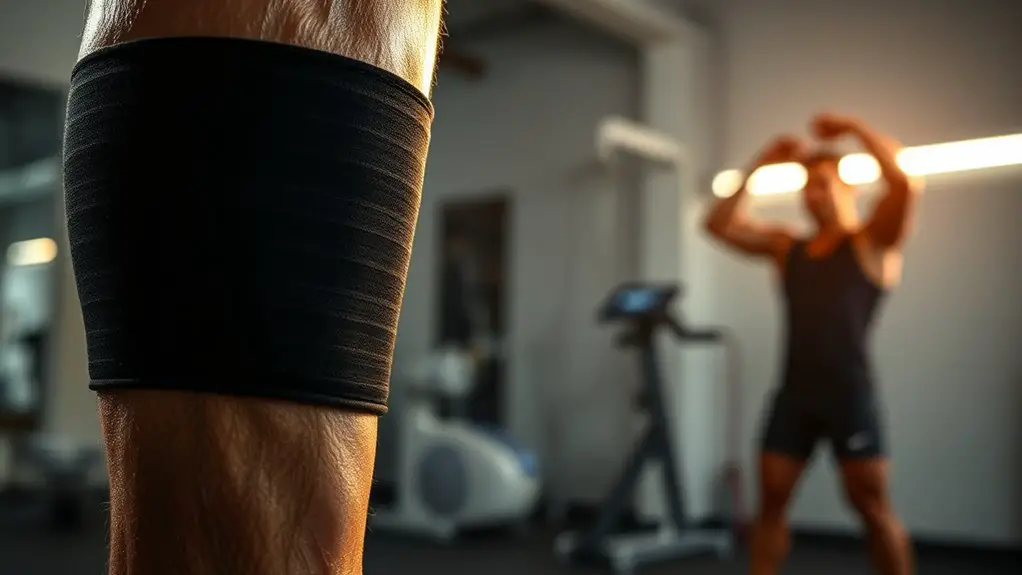Blood Flow Restriction (BFR) training speeds up healing by allowing you to safely engage your muscles with lighter weights, which stimulates your body's natural repair processes. By partially restricting blood flow, BFR increases the production of growth hormones and enhances muscle recovery. This method helps maintain muscle mass and strengthens muscle fibers, even during rehabilitation. If you're curious about the specific physiological benefits and how to incorporate BFR into your routine, there's plenty more to discover.
Understanding Blood Flow Restriction Training
Blood Flow Restriction (BFR) training, which involves restricting blood flow to your muscles during exercise, can be a game-changer for those looking to enhance strength and muscle growth without heavy lifting. By using bands or cuffs, you can create a unique environment that promotes muscle adaptation. This method allows you to lift lighter weights while still achieving impressive gains, making it ideal for those who seek freedom from traditional training limitations.
You don't need to spend hours in the gym or lift heavy to see results. Instead, BFR training lets you focus on quality over quantity, giving you the freedom to tailor your workouts to your lifestyle. Whether you're recovering from an injury or just want to spice up your routine, BFR opens doors to new possibilities. Embrace this innovative technique and discover how you can maximize your strength and muscle growth without the burden of heavy weights. Additionally, incorporating proper hydration strategies can further enhance recovery and muscle repair during your BFR training sessions.
The Science Behind BFR Training
By creating a controlled environment for muscle training, BFR relies on some interesting physiological principles. It works by partially restricting blood flow to your muscles during exercise, making them work harder with lighter weights. This restriction triggers a cascade of hormonal responses that promote muscle growth and repair, which can be a game-changer for anyone looking for efficient workouts or recovering from injuries.
Your body senses the lack of oxygen and responds by increasing the production of growth factors and other anabolic hormones. This means you can achieve similar benefits to traditional strength training without overloading your joints or risking injury. Incorporating squats into your BFR routine can further enhance lower body strength and stability.
BFR training allows you to experience the thrill of pushing your limits while keeping your body safe. By understanding these principles, you can tap into a training method that not only respects your body's needs but also empowers you on your fitness journey. So, embrace the science and let it fuel your freedom to move!
Physiological Benefits of BFR Training
When you engage in blood flow restriction (BFR) training, you can experience several physiological benefits that enhance your workouts. It not only boosts muscle recovery but also increases your hormonal response and improves circulation efficiency. Understanding these advantages can help you maximize your training results. Additionally, incorporating muscular endurance training can further enhance your overall performance in various physical activities.
Enhanced Muscle Recovery
Enhanced muscle recovery is one of the most significant physiological benefits of blood flow restriction (BFR) training, as it stimulates the body's natural healing processes. When you incorporate BFR training, you're allowing your muscles to heal faster and more efficiently. This method promotes the repair of damaged tissues by increasing the metabolic stress on your muscles without the need for heavy weights. You'll experience less soreness and quicker recovery times, giving you the freedom to push your limits without the typical downtime. Plus, it helps maintain muscle mass during rehabilitation, so you won't lose progress while recovering. Embracing BFR training means you can reclaim your strength and return to your passions sooner, enhancing your overall well-being.
Increased Hormonal Response
Although many training methods can stimulate hormonal responses, blood flow restriction (BFR) training stands out by markedly enhancing the release of growth hormone and other anabolic hormones. This increased hormonal response not only supports muscle growth but also accelerates recovery, giving you the freedom to push your limits without the usual downtime.
Key benefits of BFR training include:
- Heightened growth hormone levels: Promotes muscle repair and growth.
- Improved anabolic hormone balance: Supports overall body composition and enhances performance.
- Faster recovery: Reduces soreness and gets you back to your routine quicker.
Improved Circulation Efficiency
The hormonal boosts you experience with blood flow restriction (BFR) training also contribute to improved circulation efficiency. When you engage in BFR, your body learns to optimize blood flow, ensuring that oxygen and nutrients reach your muscles more effectively. This means you can push your limits without the usual fatigue, giving you the freedom to train harder and recover faster. As your circulation becomes more efficient, you'll notice an enhanced ability to perform daily activities and even tackle new challenges. You're not just enhancing your workouts; you're fostering a lifestyle rooted in energy. With BFR, you can elevate your fitness journey, access your potential, and embrace the feeling of freedom that comes from improved bodily function.
How BFR Training Enhances Muscle Growth
When you engage in BFR training, you're not just lifting weights—you're also triggering key processes that boost muscle growth. This method increases muscle protein synthesis and enhances your hormonal response, which can greatly reduce muscle atrophy. Understanding these mechanisms can help you maximize your training results.
Increased Muscle Protein Synthesis
While traditional resistance training effectively stimulates muscle growth, Blood Flow Restriction (BFR) training offers a unique approach that markedly enhances muscle protein synthesis. By restricting blood flow to your muscles during exercise, you create an environment that pushes your body to adapt and grow stronger. This method can lead to significant gains, even with lighter weights.
- Stimulates muscle fibers: BFR training activates more muscle fibers than traditional methods.
- Increases metabolic stress: The accumulation of metabolites promotes muscle growth.
- Promotes recovery: Enhanced protein synthesis aids in quicker recovery and growth.
Embracing BFR training can unveil new potential in your fitness journey, allowing you to achieve your muscle growth goals with less strain on your body.
Enhanced Hormonal Response
Blood Flow Restriction (BFR) training not only stimulates muscle fibers but also greatly enhances your hormonal response, which plays an important role in muscle growth. When you apply BFR, your body releases key hormones like growth hormone and testosterone, which are crucial for building muscle and improving recovery. These hormones increase protein synthesis, allowing your muscles to repair and grow stronger. You'll find that even with lighter weights, the hormonal surge can lead to significant gains, giving you the freedom to achieve your fitness goals without overloading your body. This method empowers you to train smart, ensuring you're maximizing your potential while minimizing the risk of injury. Embrace BFR training and unleash a powerful hormonal response that fuels your journey to strength.
Reduced Muscle Atrophy
Although traditional strength training can lead to muscle atrophy during periods of inactivity, Blood Flow Restriction (BFR) training offers a compelling solution to this challenge. With BFR, you can maintain and even enhance muscle growth without heavy lifting. This method creates a unique environment that stimulates muscle fibers and promotes hypertrophy, even when you're not able to train like usual.
- Increased muscle activation: BFR targets fast-twitch muscle fibers, essential for growth.
- Lower load requirements: You can achieve results with lighter weights, reducing stress on joints.
- Faster recovery: BFR helps minimize downtime, allowing you to get back to your routine sooner.
Embrace BFR training to access your potential and keep muscle loss at bay, even when life gets in the way!
BFR Training and Injury Recovery
When you're recovering from an injury, finding effective ways to maintain muscle strength can be challenging. Blood Flow Restriction (BFR) training offers a unique solution that allows you to safely engage your muscles without overexerting yourself. By applying a specialized device around your limbs, you can reduce blood flow while still performing low-intensity exercises. This method promotes muscle growth and strength, even when you're limited by pain or mobility issues.
BFR training encourages faster healing by stimulating the body's natural repair processes. You'll notice improvements in muscle size and strength, which can help you regain your functionality more quickly. Plus, it's a way to maintain your independence during recovery, allowing you to work on your goals without the constraints of traditional rehabilitation methods. Embracing BFR training could be the key to reclaiming your strength and freedom as you navigate your healing journey. Additionally, resistance band training can further enhance injury prevention and rehabilitation, providing a versatile tool to support your recovery efforts.
Applications of BFR Training in Rehabilitation
As you explore the applications of BFR training in rehabilitation, you'll find it offers versatile benefits tailored to various injuries and conditions. This training method can help you regain strength and functionality without placing excessive strain on your body. Whether you're recovering from surgery or dealing with chronic pain, BFR can be a game-changer.
- Post-surgical recovery: It accelerates healing while minimizing muscle loss.
- Chronic pain management: Strengthens muscles gently, easing discomfort.
- Sports injury rehabilitation: Enhances recovery speed, allowing athletes to return to play sooner.
Safety Considerations for BFR Training
While BFR training can be highly effective, it's vital to prioritize safety to avoid potential complications. First, make certain you consult with a healthcare professional before starting, especially if you have underlying health issues. Using proper equipment is imperative; always opt for quality bands designed for BFR to guarantee appropriate pressure. You should also monitor how your body reacts during training. If you feel any unusual pain, numbness, or excessive discomfort, it's best to stop immediately. Start with lower intensity and gradually increase as you become more comfortable. Keep sessions short—generally no longer than 20-30 minutes—to reduce risks. Finally, stay hydrated and listen to your body; it knows best. Additionally, incorporating proper warm-ups can further enhance your safety and performance during BFR training. By following these safety guidelines, you can enjoy the freedom and benefits of BFR training while minimizing any potential risks. Prioritize your well-being, and you'll set yourself up for successful, enjoyable workouts.
Incorporating BFR Training Into Your Routine
Incorporating BFR training into your routine can be a game-changer for achieving fitness goals, especially if you're looking to enhance muscle growth and strength. This innovative method allows you to work out with lighter weights while still maximizing your results. To get started, keep these tips in mind:
- Start Slow: Gradually introduce BFR into your workouts, focusing on form and technique.
- Choose the Right Equipment: Use specialized bands or cuffs designed for BFR to guarantee safety and effectiveness.
- Monitor Your Body: Pay attention to how you feel during and after workouts, adjusting pressure levels as needed. Furthermore, incorporating flexibility and mobility work can help enhance your joint function and decrease injury risk.
With BFR, you can train smarter, not harder, giving you the freedom to reach your goals without the wear and tear of heavy lifting. Embrace the journey, and watch your strength and muscle definition soar!
Future Perspectives on BFR Training and Healing
BFR training isn't just about enhancing muscle growth; it's also gaining attention for its potential in rehabilitation and healing. As you explore this cutting-edge approach, you might envision a future where BFR techniques are seamlessly integrated into recovery protocols. Imagine using BFR not only to bounce back from injuries but also to enhance post-surgical healing.
Research is steadily uncovering how BFR can accelerate tissue repair and reduce rehab time, giving you the freedom to reclaim your active lifestyle sooner. With advancements in technology, personalized BFR devices could soon be at your fingertips, making it easier than ever to incorporate into your recovery plans.
As more athletes and fitness enthusiasts embrace BFR, the conversation around its benefits will only grow. You'll have the opportunity to harness this innovative training method, transforming not just how you build strength, but how you heal. The future looks promising, and it's time to explore those possibilities.
Frequently Asked Questions
Can BFR Training Be Used by Older Adults?
Absolutely, BFR training can be beneficial for older adults. It allows you to maintain strength and muscle mass with less strain on your joints, promoting fitness and independence without the risks associated with heavy lifting.
How Often Should BFR Training Sessions Be Conducted?
You might think cramming BFR sessions into every day's a shortcut, but it's not. Aim for two to three times a week. Your body needs time to recover; freedom lies in balanced training, not overdoing it.
Is BFR Training Safe for Individuals With Diabetes?
BFR training can be safe for individuals with diabetes, but it's essential to consult your healthcare provider first. They'll help guarantee your approach aligns with your unique health needs and fitness goals. Stay informed and cautious!
What Equipment Is Needed for BFR Training at Home?
To commence your journey of BFR training at home, you'll need bands or cuffs, weights, and a sturdy anchor. Each piece symbolizes your commitment to freedom, revealing strength and resilience within you.
Are There Any Contraindications for BFR Training?
Yes, there are contraindications for BFR training. It's not recommended if you have certain conditions like high blood pressure, vascular issues, or a history of blood clots. Always consult a healthcare professional before starting.




